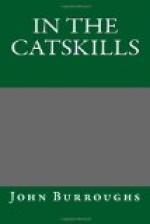The Baltimore oriole loves to attach its nest to the swaying branches of the tallest elms, making no attempt at concealment, but satisfied if the position be high and the branch pendent. This nest would seem to cost more time and skill than any other bird structure. A peculiar flax-like substance seems to be always sought after and always found. The nest when completed assumes the form of a large, suspended gourd. The walls are thin but firm, and proof against the most driving rain. The mouth is hemmed or overhanded with horse-hair, and the sides are usually sewed through and through with the same.
Not particular as to the matter of secrecy, the bird is not particular as to material, so that it be of the nature of strings or threads. A lady friend once told me that, while working by an open window, one of these birds approached during her momentary absence, and, seizing a skein of some kind of thread or yarn, made off with it to its half-finished nest. But the perverse yarn caught fast in the branches, and, in the bird’s effort to extricate it, got hopelessly tangled. She tugged away at it all day, but was finally obliged to content herself with a few detached portions. The fluttering strings were an eyesore to her ever after, and, passing and repassing, she would give them a spiteful jerk, as much as to say, “There is that confounded yarn that gave me so much trouble.”
From Pennsylvania, Vincent Barnard (to whom I am indebted for other curious facts) sent me this interesting story of an oriole. He says a friend of his curious in such things, on observing the bird beginning to build, hung out near the prospective nest skeins of many-colored zephyr yarn, which the eager artist readily appropriated. He managed it so that the bird used nearly equal quantities of various high, bright colors. The nest was made unusually deep and capacious, and it may be questioned if such a thing of beauty was ever before woven by the cunning of a bird.
Nuttall, by far the most genial of American ornithologists, relates the following:—
“A female (oriole), which I observed attentively, carried off to her nest a piece of lamp-wick ten or twelve feet long. This long string and many other shorter ones were left hanging out for about a week before both the ends were wattled into the sides of the nest. Some other little birds, making use of similar materials, at times twitched these flowing ends, and generally brought out the busy Baltimore from her occupation in great anger.
“I may perhaps claim indulgence for adding a little more of the biography of this particular bird, as a representative also of the instincts of her race. She completed the nest in about a week’s time, without any aid from her mate, who indeed appeared but seldom in her company and was now become nearly silent. For fibrous materials she broke, hackled, and gathered the flax of the asclepias and hibiscus stalks, tearing off long strings and flying with them




